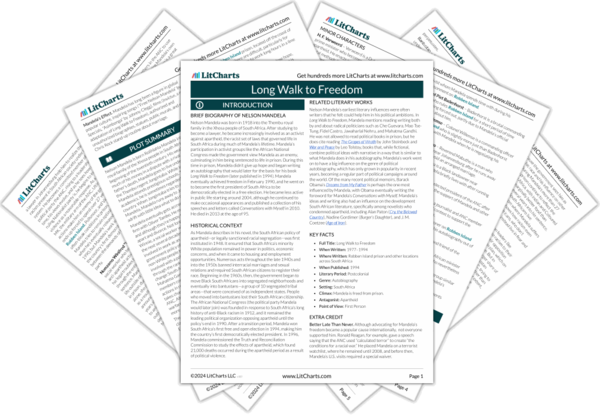Nelson Mandela is one of the few Black men in South Africa to own a car, and the car becomes a symbol of his independence and self-sufficiency—which the government wants to take away under the apartheid system. Mandela’s ability to procure a car testifies to both his hard-working attitude as well as to the comparatively privileged situation compared to other Black South Africans, since he was born as a member of Thembu royal family. Importantly, however, Mandela doesn’t just use his privilege for himself—his car becomes a means for him to travel around the country and get involved in political organizing, even taxiing other activists around. When Mandela starts to become a popular figure, the government issues travel bans on him, trying to limit his autonomy by controlling where he can drive his car.
Although Mandela likes his car and makes good use of it when he can, cars also sometimes play a darker role in his life. Mandela’s son Thembi dies in a car accident, and his wife Winnie is later injured in another accident. This reflects how the freedom that cars represent also comes with dangers and costs. Still, the book ends with a triumphant image of Mandela in a car being driven out of prison with Winnie. Mandela’s drive from prison in a car reflects how his autonomy has been restored to him after decades of travel bans and imprisonments designed to take his independence away. Cars in Long Walk to Freedom thus represent the autonomy and mobility of Black South Africans that the government tries to take away, and while this autonomy can sometimes be difficult to attain or come with costs, Mandela’s drive out of prison at the end of the book offers hope for a better future in which all South Africans have autonomy and equal rights.
Car Quotes in Long Walk to Freedom
De Klerk again excused himself and left the room. After ten minutes he returned with a compromise: yes, I could be released at Victor Verster, but, no, the release could not be postponed. The government had already informed the foreign press that I was to be set free tomorrow and felt they could not renege on that statement. I felt I could not argue with that. In the end, we agreed on the compromise, and Mr. de Klerk poured a tumbler of whisky for each of us to drink in celebration. I raised the glass in a toast, but only pretended to drink; such spirits are too strong for me.










